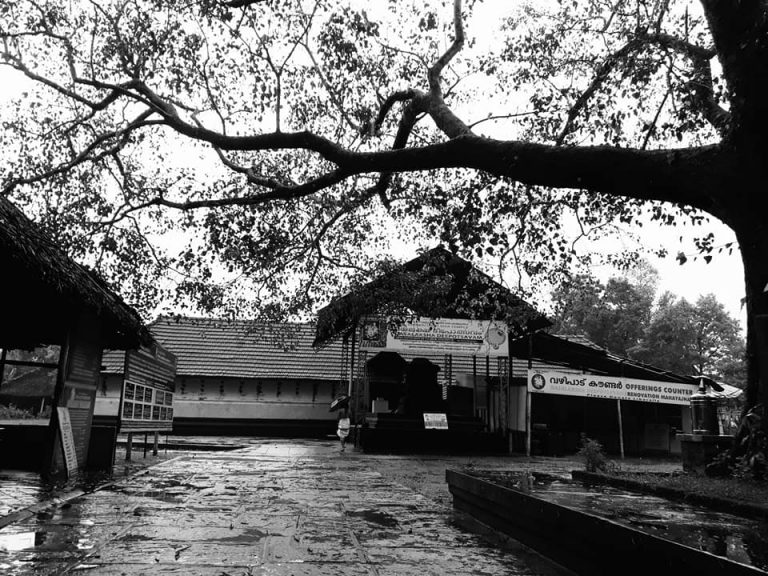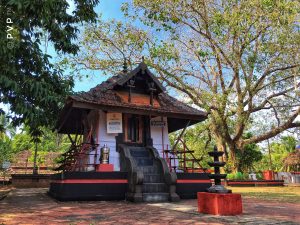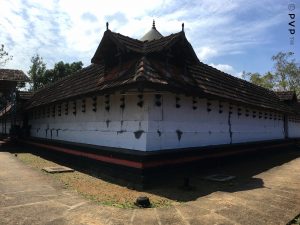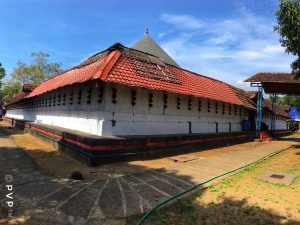Sree Mahadeva Temple, Chowallor
Sree Mahadeva Temple, Chowallor






The temple dates back to ancient period. In those days the temple was owned by 28 Malayala Brahmin families. The legend says that a pious Nampoothiri of one of these illams was a great devotee of Lord Vadakkumnathan at Trissur and he used to go there for regular worship. When he became old he found it difficult to trek the distance from the present Chowalloor to Trissur. One day after his visit to Sree Vadakkumnathan temple he became very much tired and fell into sleep. That night he had a dream that the Lord had decided to bless him by appearing as swayambhoo idol on the top of a small hill close to his illam. Next day morning he went there and to his great astonishment, he found a swayambhoo idol. Immediate arrangements were then made to build a temple there. In course of time all the 28 illams became extinct and the temple was taken over by Mazhuvannoor mana. This mana also became extinct and the administration of the temple came into the hands of Tazhakkulam mana. After the implementation of the Land Reforms Act this mana found it difficult to manage the temple and that family had to leave this place for their livelihood. There was none to look after the temple. At this stage the local devotees met and decided to take over the temple. Accordingly on 4th December 1984 a local eleven-member committee elected by devotees took over its administration with the concurrence of the Cochin Devaswam Board. It is claimed to be one of the 108 important shrines in the West-coast of India. Though some local people maintain the view that the idol was consecrated by Lord Parasurama, on verification the idol appears to be swayambhoo.
Details of land owned by the temple prior to the Land Reforms Act are not known. At present the temple owns 3.22 acres of land of which an extent of 22 cents is under paddy fields. The temple complex having an extent of 2.80 acres has Sreekovil, namaskaara-mandapam, chuttambalam, valiya-balikkall, sub-shrines, office building, kokkarani and pond.
The circular dwi-thala Sreekovil of sandhaara type and facing west has granite adhishthaanam with mouldings of paadukam, jagathi, triple-faceted kumudam, kumuda-padi, galam with flower motifs, gala-padi, utharam, kampam, galam with flower motifs, gala-padi, valaru and padi.. The sopanam has six direct steps with vyaali face at the top and niches and flower motifs on the sides of banisters. The pranaalam has makara-simha face with multi-faceted sundu with rings and gomukha end. It is supported by a pillar. The walls built with laterite stones have six ghanadwaaras and four functional doors (sarvatobadra type). In 1993 the roof of eka-thala part was made of dressed laterite stones and that of the dwi-thala part was tiled. There is a proposal to renovate the roof with concrete. The namaskaara-mandapam has 16 granite pillars, Nandi and deepastambham are installed within this mandapam. The well is at northeast of the akathe-balivattam and the receipt counter at its northwest.
The chuttambalam has entrances from west and east. There are doors on either side of the valiyambalam. The mulayara is at northeast corner. The thidappali is at southeast. A special feature is that saptha-matrikkals are installed within the southern naalambalam instead of the usual place at the southern anthar-mandalam. The sub-shrine at southwest of the naalambalam has two idols, Lord Ganapati and Lord Ayyappa. The valiya-balikkall is installed outside the chuttambalam and within a nada-panthal. There is a sub shrine at southwest facing east dedicated to Lord Simhodharan. The kokkarani and temple pond are at northeast.
There is an inscription in old script on the southern side of the kumuda-padi of the adhishthaanam of the Sreekovil. It is reported that in the inscription there is mention about the donation of two nilavilakkus (bronze stand-lamps). Beautiful dwaarapalakas carved in sila are seen on either side of the prasada dwaram. There are woodcarvings on the outer wall of Sreekovil depicting half upper portions of elephants. Above the head portion of these elephant- motifs wood carvings of Devaganas and other figurines are fixed touching the beams of Sreekovil.
The main idol of Lord Siva is swayambhoo and has a height of 1.5 kolu. At the rear of this Siva idol there is a daru-silpa idol (height: 2 kolu) of Goddess Parvathi. At its front a sila idol of mirror type is also installed. All other idols are made of sila and of sitting poses, Lord Ganapati (30 cm.), Lord Ayyappa (15 cm.), Sree Simhodharan (60 cm.).
The temple is kept open from 5 to 10-30 a.m. and from 5 to 8 p.m. Three poojas are done daily,
Usha-pooja (6 a.m.),
Uccha-pooja (8-30 a.m.) and
Athaazha-pooja (7-30 p.m.)
Jaladhara, pushpanjali, dampati-pooja, mruthumjaya-homam, sharkara payasam, pal-payasam and koottu-payasam are the main vazhipadu. Only one mruthumjaya-homam and one Uma Maheswara Pooja will be performed in a day.
Sivarathri is observed with special rites like navakam, pancha-gavyam, suddhi-kalasam, special poojas, ezhunnellath and entertainments. Navaratri is also observed with special poojas. Thiruvathira is also considered an auspicious day. On that day Kathakali is usually staged.
Details of the person who performed initial rites to the swayambhoo idol are not known. The present thantri belongs to Azhakath mana of Kozhikkottiri (Pattambi). The shanthikkar are appointed from Malayala Brahmins. Other staff includes, Marar, peon, clerk, watchman, adichu-tali and manager.
Situated three km. east of Guruvayoor at Kandanasseri and thence 25 m. on Paris road, the temple is connected by tarred road. Facilities for stay are available at Guruvayoor.




